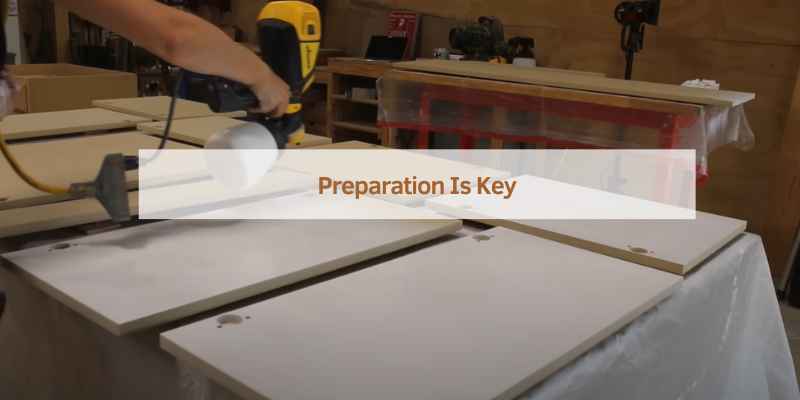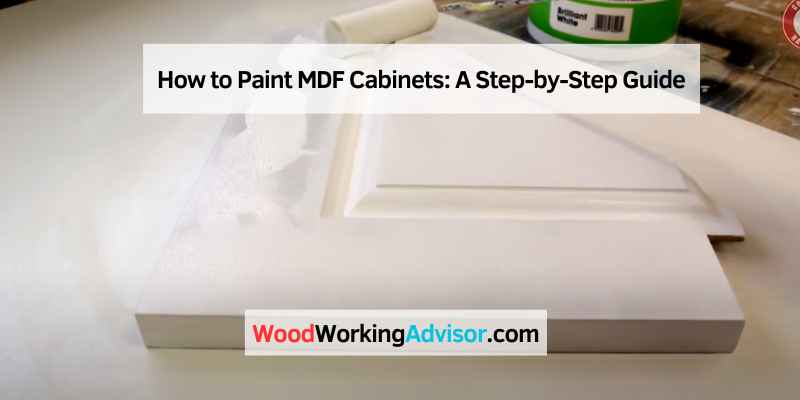To paint MDF cabinets, clean and sand the surfaces. Apply a primer, then paint with a suitable finish.
Painting MDF cabinets can transform your kitchen or bathroom at a low cost. MDF, or Medium Density Fiberboard, is a popular choice for cabinets due to its smooth surface and affordability. Proper preparation is crucial for a lasting finish. Start by cleaning the cabinets to remove any grease or dirt.
Sanding ensures the primer adheres well. Use a high-quality primer designed for MDF to seal the surface and prevent moisture damage. After priming, choose a durable paint that matches your desired look. Applying multiple thin coats will yield the best results. This method ensures your cabinets look professional and withstand daily use.
Preparation Is Key
Before you start painting MDF cabinets, preparation is crucial. Proper preparation ensures a smooth and long-lasting finish. Taking time to prep will make the painting process easier and more effective. Here’s how you can get started.
Gathering Your Materials
First, gather all necessary materials. Here’s a list of what you’ll need:
- Medium-density fiberboard (MDF) cabinets
- Primer
- Paint (latex or oil-based)
- Sandpaper (220-grit)
- Paintbrushes and rollers
- Drop cloths
- Painters tape
- Tack cloth
- Screwdriver (for removing hardware)
Having everything ready will save you time and make the process smoother. Make sure to check all items before starting your project.
Safety Considerations
Safety is important when painting MDF cabinets. Follow these tips to stay safe:
- Work in a well-ventilated area
- Wear a dust mask when sanding
- Use gloves to protect your hands
- Keep a first aid kit nearby
Safety gear is essential for any painting project. It keeps you protected from dust and fumes.
Ventilation helps in drying the paint faster. It also reduces exposure to harmful fumes. Always prioritize your safety and comfort.

Initial Steps
Painting MDF cabinets can transform your kitchen or bathroom. Before starting, follow these initial steps to ensure a smooth and professional finish. Proper preparation is crucial.
Removing Hardware
First, remove all the hardware from your MDF cabinets. This includes handles, knobs, and hinges. Place these items in a safe container. Label them if needed to avoid confusion during reassembly.
| Item | Action |
|---|---|
| Handles | Remove and store in a labeled container |
| Knobs | Remove and store in a labeled container |
| Hinges | Remove and store in a labeled container |
Cleaning Surfaces
Next, clean the surfaces of your MDF cabinets. Use a mild cleaner and a soft cloth. This removes grease, dirt, and dust. Clean surfaces ensure the paint adheres properly.
- Use a mild cleaner
- Wipe with a soft cloth
- Remove all grease and dirt
Allow the surfaces to dry completely before moving to the next step. Wet surfaces can cause issues with paint adhesion.
For stubborn stains, use a gentle scrub brush. Avoid using too much water, as MDF can swell when wet.
Sanding Mdf Cabinets
Preparing your MDF cabinets for painting starts with proper sanding. Sanding is essential to achieve a smooth, professional finish. This step ensures the paint adheres well to the surface, providing durability and a sleek appearance.
Selecting The Right Sandpaper
Choosing the right sandpaper is crucial for effective sanding. Use a medium-grit sandpaper for the initial sanding. A grit size of 120 to 150 works best to remove surface imperfections without damaging the MDF.
After the initial sanding, switch to a fine-grit sandpaper for a smoother finish. A grit size of 220 is ideal for this purpose. It helps to smooth out any rough spots and prepare the surface for priming.
Techniques For Effective Sanding
Proper technique ensures that the sanding process is effective and efficient. Here are some tips:
- Always sand in the direction of the grain to avoid scratches.
- Use a sanding block or a sanding sponge to maintain even pressure.
- For hard-to-reach areas, use a folded piece of sandpaper.
- Avoid over-sanding, as it can damage the MDF surface.
After sanding, remove dust with a tack cloth or a damp rag. This step ensures a clean surface for priming and painting.
Follow these steps to achieve a smooth, ready-to-paint surface on your MDF cabinets. Proper sanding is the key to a professional finish.
Priming Surfaces
Priming is a key step when painting MDF cabinets. It ensures the paint adheres well and lasts longer. Proper priming also helps to achieve a smooth, professional finish.
Choosing The Right Primer
Choosing the right primer is crucial for a successful paint job. Oil-based primers are excellent for sealing MDF surfaces. They prevent moisture from seeping in and causing damage. Shellac-based primers are another great option. They dry quickly and block stains effectively.
| Type of Primer | Benefits |
|---|---|
| Oil-based | Seals MDF, prevents moisture damage |
| Shellac-based | Quick drying, excellent stain blocking |
Application Tips For Smooth Coverage
To achieve smooth coverage, follow these tips:
- Clean the MDF surfaces thoroughly before priming. Dust and dirt can affect adhesion.
- Sand the surfaces lightly with fine-grit sandpaper. This helps the primer stick better.
- Use a high-quality brush or roller for application. Cheap tools can leave streaks and lint.
- Apply the primer in thin, even coats. Thick layers can cause drips and uneven surfaces.
- Allow adequate drying time between coats. Check the primer label for specific drying times.
By following these steps, you can ensure that your MDF cabinets have a smooth, durable base for painting.
Selecting Your Paint
Choosing the right paint for your MDF cabinets is essential. This step determines the final look and durability of your cabinets. Whether you prefer a modern, sleek finish or a rustic charm, the paint you select plays a critical role.
Oil Vs. Water-based Options
When selecting paint, you will find two main types: oil-based and water-based.
| Type of Paint | Advantages | Disadvantages |
|---|---|---|
| Oil-Based Paint |
|
|
| Water-Based Paint |
|
|
Picking The Perfect Color
Color choice impacts the overall vibe of your kitchen or bathroom. Here are some tips to pick the perfect color:
- Consider your room’s lighting: Light colors make a space feel larger. Dark colors add warmth.
- Match with existing décor: Ensure your cabinet color complements your walls and furniture.
- Think about maintenance: Light colors show dirt easily. Dark colors hide scratches better.
Popular colors for MDF cabinets include:
- White: Timeless and versatile
- Gray: Modern and chic
- Blue: Calming and stylish
- Green: Refreshing and unique
Choose a color that reflects your style and meets your practical needs. Your paint choice will transform your MDF cabinets beautifully.
Painting Techniques
Painting MDF cabinets can transform your kitchen or bathroom. Using the right techniques is essential. This guide will help you choose the best method to achieve a professional finish.
Brush, Roller, Or Spray?
Choosing the right tool is crucial. Each method has its benefits and drawbacks. Below is a comparison:
| Tool | Pros | Cons |
|---|---|---|
| Brush |
|
|
| Roller |
|
|
| Spray |
|
|
Achieving An Even Coat
An even coat is important for a professional look. Follow these steps to ensure a smooth finish:
- Prepare the surface: Sand the MDF to remove rough spots. Clean off any dust.
- Prime the MDF: Use a high-quality primer. This helps the paint adhere better.
- Choose the right paint: Use paint designed for cabinets. It will be more durable.
- Apply thin coats: Multiple thin coats are better than one thick coat. This prevents drips.
- Sanding between coats: Lightly sand between coats. This ensures a smooth finish.
Using the right technique ensures your MDF cabinets look great. Whether you use a brush, roller, or spray, follow these steps for the best results.
Finishing Touches
After painting your MDF cabinets, the finishing touches are crucial. These steps ensure your work looks professional. They also help your cabinets last longer. This section covers reattaching hardware and curing and care instructions.
Reattaching Hardware
Once the paint has dried, it’s time to reattach the hardware. This includes handles, knobs, and hinges.
- Clean the hardware before attaching it. This removes any dust or old paint.
- Use a screwdriver to carefully place the screws back into the holes.
- Make sure each piece of hardware is aligned properly. This ensures doors and drawers open smoothly.
Tighten the screws but avoid over-tightening. Over-tightening can strip the screws or damage the paint.
Curing And Care Instructions
After reattaching the hardware, the paint needs to cure. Curing is an important step for durability.
- Allow the paint to cure for at least 7 days. Avoid using the cabinets during this time.
- Keep the room well-ventilated. This speeds up the curing process.
- Avoid placing heavy objects on the cabinets during curing.
Once cured, follow these care instructions to maintain your cabinets:
| Action | Frequency |
|---|---|
| Wipe with a damp cloth | Weekly |
| Avoid abrasive cleaners | Always |
| Check hardware for tightness | Monthly |
Using gentle cleaning products will keep your paint looking fresh. Regular maintenance ensures long-lasting beauty.
Troubleshooting Common Issues
Painting MDF cabinets can be rewarding, but sometimes issues arise. This section helps you troubleshoot common problems. Learn how to deal with drips, runs, and uneven finishes.
Dealing With Drips And Runs
Drips and runs can ruin the look of your cabinets. Follow these steps to fix them:
- Identify the problem areas: Look for thick paint spots.
- Use a scraper: Gently scrape off the drips with a plastic scraper.
- Sand the area: Use fine-grit sandpaper to smooth out the surface.
- Repaint: Apply a thin coat of paint to the sanded area.
Fixing Uneven Finishes
Uneven finishes can make your cabinets look unprofessional. Use these tips to achieve a smooth finish:
- Check your painting technique: Use even strokes and maintain a wet edge.
- Sand between coats: Lightly sand the surface after each coat dries.
- Use a primer: Apply a primer to ensure the paint adheres evenly.
- Apply multiple thin coats: Thin coats dry faster and result in a smoother finish.
By following these tips, you can troubleshoot common painting issues. Ensure your MDF cabinets look professional and polished.
Showcasing Your Work
After spending time and effort painting your MDF cabinets, it’s important to showcase your work. Proper styling and maintenance can help highlight your newly painted cabinets. Here are some tips to help you present your work in the best light.
Styling Your Newly Painted Cabinets
Styling your newly painted cabinets can enhance their beauty. Here are some ideas to get you started:
- Add decorative hardware: Choose stylish knobs and handles that complement your paint color.
- Use under-cabinet lighting: Install lights to highlight your cabinets and make your kitchen brighter.
- Accessorize with matching items: Display items that match the color of your cabinets, such as vases or bowls.
- Incorporate open shelving: Replace some cabinet doors with open shelves to showcase beautiful dishes or glassware.
Maintenance Tips
Keeping your painted MDF cabinets looking fresh requires some maintenance. Here are some tips to ensure they stay in great condition:
- Regular cleaning: Wipe down your cabinets with a damp cloth to remove dust and spills.
- Avoid harsh chemicals: Use mild soap and water for cleaning to prevent damage to the paint.
- Check for chips and scratches: Touch up any damaged areas with leftover paint to maintain a smooth finish.
- Protect from moisture: Make sure your cabinets are dry to prevent swelling and damage.
By following these styling and maintenance tips, you can ensure your MDF cabinets remain stunning and functional for years.

Frequently Asked Questions
What Kind Of Paint Do You Use On Mdf Cabinets?
Use high-quality acrylic latex paint or oil-based paint for MDF cabinets. Apply a primer first for best results.
Do I Need To Prime Mdf Before Painting?
Yes, you need to prime MDF before painting. Priming seals the surface, ensuring better paint adhesion and a smooth finish.
Is It Worth Painting Mdf Kitchen Cabinets?
Yes, painting MDF kitchen cabinets is worth it. It updates the look, adds protection, and is cost-effective.
How To Change The Color Of Mdf Cabinets?
To change the color of MDF cabinets, clean the surface, sand lightly, apply a primer, then paint with your desired color.
Conclusion
Transforming your MDF cabinets with a fresh coat of paint is a rewarding project. Follow the steps outlined to achieve a professional finish. Take your time, use quality materials, and enjoy the process. Your revamped cabinets will bring new life to your space, adding both beauty and value.


